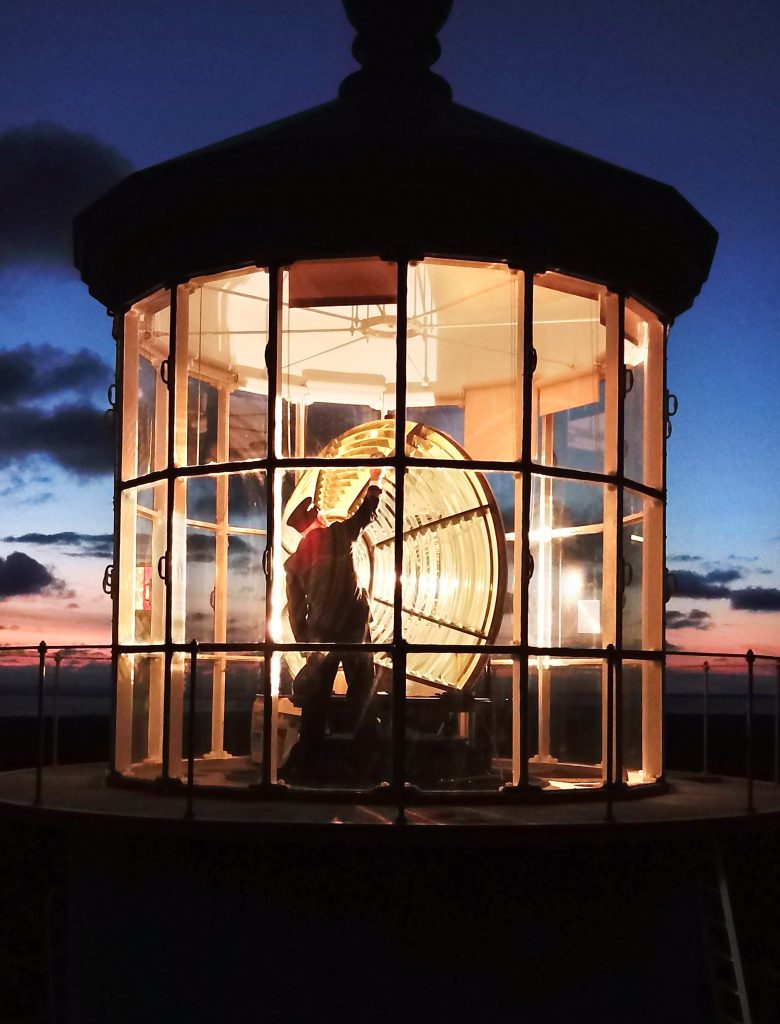As a towering symbol of Washington State’s rich maritime heritage, the Westport Grays Harbor Lighthouse stands majestically. The historic beacon of light has guided ships into Grays Harbor, saving lives and boosting the local economy for more than 120 years. Reaching 107 feet tall, it is the tallest lighthouse in the state and is ranked the third tallest on the West Coast, surpassed only by California’s Pigeon Point and Point Arena lighthouses, towering at 115 feet.
“The Light was a cornerstone of the economy and development of Grays Harbor,” says John Shaw, executive director of the Westport South Beach Historical Society. “And after 126 years, it is still a monument to our area’s history, and an active aid to navigation shining its light.”

Westport Lighthouse History
Construction of the Grays Harbor Lighthouse started in 1897 when navigating the Pacific coast was extremely perilous. Alongside the life-saving services United States Lighthouse Establishment (USLHE) and the United States Life-Saving Service (USLSS), the Westport Lighthouse was a vital safeguard for commercial vessels.
“The Lighthouse proposition made by area businessmen in the late 1800s called on congress to fund elements needed for safer navigation,” explains Shaw. “The number of ships lost was not acceptable.”
On June 30, 1898, the Westport Lighthouse became fully operational. Soon after, construction of the south jetty began, which would forever change the landscape. It originally stood about 2,400 feet from the high-water mark, and this provided a clear view of the ocean. But by the early 1900s, efforts to stabilize the shifting sands – through planting European beachgrass – began to alter the area dramatically.
“The most common question we get is explaining that the Lighthouse was not moved,” shares Shaw. “That the distance directly to the west between the Lighthouse and surf is about the same as it was originally.”
The Westport Lighthouse holds deep significance for the local community. Designed by principal lighthouse architect Carl W. Leick, the Grays Harbor Westport Lighthouse was considered a masterwork of lighthouse design for the West Coast. According to information from the Westport South Beach Historical Society, the Westport Lighthouse became the principal aid to navigation off Grays Harbor, which opened up safe shipping, and along with the jetties, created one of the busiest ports on the West Coast. By 1905, Grays Harbor had become the world’s largest timber shipping port, with the lighthouse serving as a cornerstone of the region’s economy and development.

Grays Harbor Lighthouse’s Impact on Community and Tourism
The Westport Lighthouse was Grays Harbor’s first tourist attraction. “Well before the road connected the South Beach,” shares Shaw, “the Sternwheelers would drop off tourists from up harbor to the Pacific Avenue wharf where they would take wagons to the beach at Ocean Avenue and could continue all the way to the Toke Point.”
According to Shaw, a legend that was proven true after finding the story in the logbooks reveals that upon the initial opening of the Westport Lighthouse, Keepers (maintenance crew) were under orders to host tourists on Sunday. “They filed regular complaints about this,” says Shaw, “as the tourists would track dirt into the lighthouse requiring additional work by the Keepers who were fastidious in the care and cleaning of the Lens and columb.”
The Westport Lighthouse, along with the Lifesaving Station, brought Keepers and Crews along with families who were some of the early permanent residents on the peninsula. “With this aid to navigation,” says Shaw, “along with Life Saving capacity, the late 19th and early 20th century saw Grays Harbor become the United States’ leading lumber port.”
The Westport Lighthouse as a guide, gave smaller coastal craft the ability to venture beyond the inner Harbor and return safely. And fishing as an industry also began in earnest. “It is Grays Harbor’s first true tourist attraction,” says Shaw. “And visitors today can get a glimpse of what it was like to take the sternwheeler to the Westport Wharf long before roads connected the area and take a buggy ride to the lighthouse and also to the south beach and enjoy the sandy beaches all the way to Toke Point.”
Today’s visitors can still get a sense of that early adventure, imagining the windswept coast as it was more than a century ago.

Preservation Efforts for Westport Lighthouse
Preserving the Westport Lighthouse structure remains a priority but restoring its historical setting presents a more complex challenge. “The light is still an active aid to navigation,” says Shaw, emphasizing that despite the shifting landscape, the Westport Lighthouse’s core mission remains the same.
In 2004, the Westport South Beach Historical Society took ownership of the Westport Lighthouse, and volunteers have since worked hard to restore and maintain the building. Visitors today can climb the lighthouse’s 135 steps to the top, where they are rewarded with breathtaking views of the coast. For many, it is an opportunity to step back in time and imagine the Westport Lighthouse as it was in the early 20th century as an essential guardian of the sea.













































